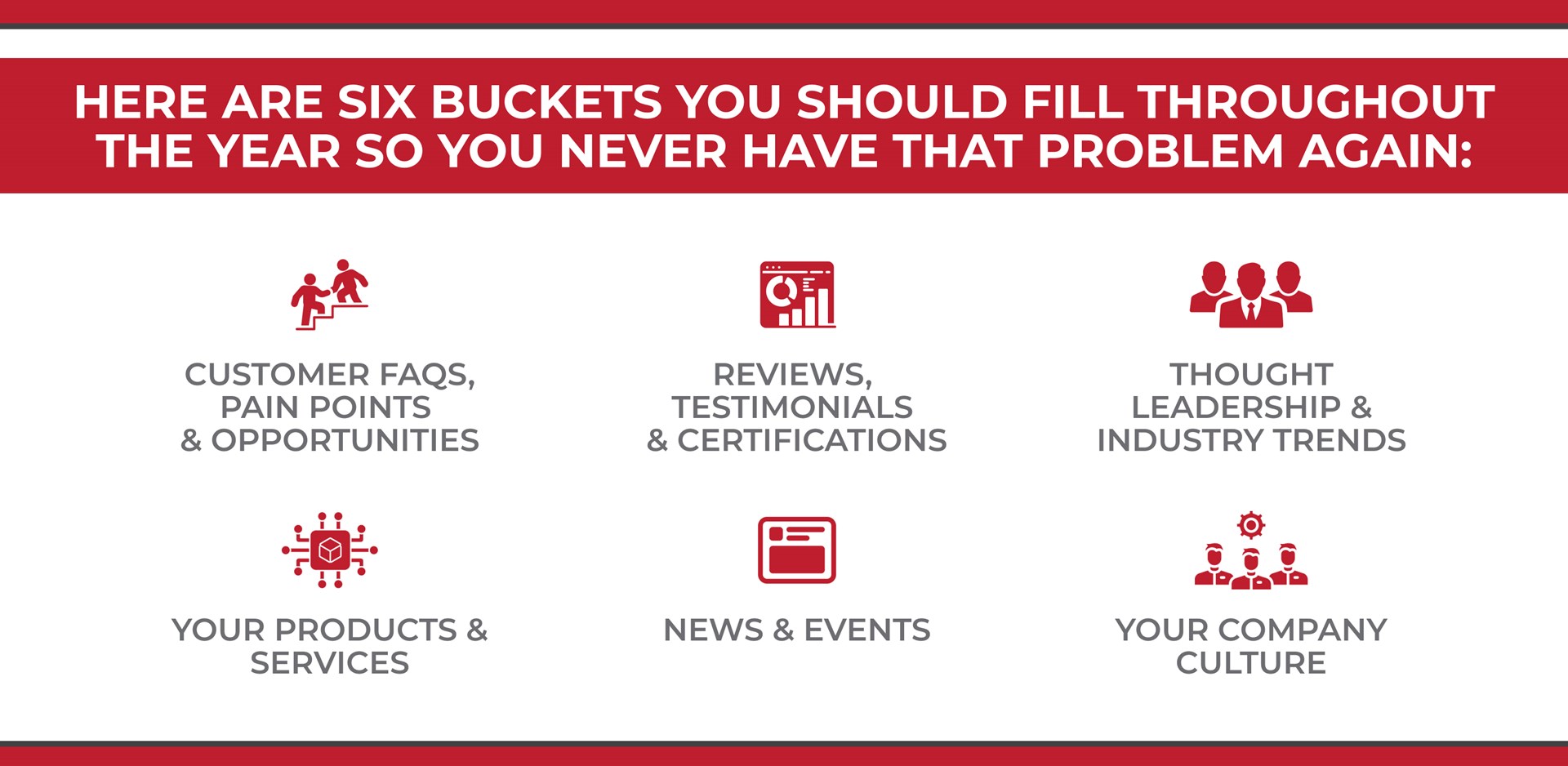I Have No Idea What to Talk About Anymore.
Most marketers can relate to that feeling. Whether you write blog content, host a podcast, run webinars, send an e-newsletter, produce videos, or create ads, you’ve probably been tapped out of ideas.
When you don’t know what to say, you focus on what you do know–which is your company and/or the features and benefits of your products and services. But, unfortunately, talking about yourself is a terrible way to approach marketing and sales.
Those six buckets represent a core part of the larger marketing content framework we use at Red Caffeine. That method allows us to organize our foundational messaging and plan campaigns with specific objectives.
Six buckets allow you to cover a wide range of subjects. Think of this as a six-piece pie in which buckets one and two should represent the most significant and important pieces, while buckets five and six are the smallest and least important for driving new business.

Here’s how you can use these buckets.
Bucket 1:
Customer FAQs, Pain Points, and Opportunities
The most valuable content addresses your customers’ challenges. It ranks well in search results and positions your company as a knowledgeable resource because it answers customers’ questions.
Providing answers or advice with empathy shows that you understand their industry and their unique situation and that you’re on their side as a partner who wants to help them succeed.
This is the most critical bucket because it forces companies to be audience-centric rather than quickly falling into old habits in which you talk about yourself too much.
Bucket 2:
Case Studies, Reviews, Testimonials, and Certifications
There’s no better way to show credibility than third-party testimonials and reviews from satisfied customers. They let others know what working with your company is like and why they should choose you. Best of all, third-party quotes are trusted by buyers more than any statements made by your company.
Case studies show prospects how you approach problems they likely understand and how you solve them to produce valuable results.
Finally, if industry benchmarks like ISO certification, for example, appear on a customer’s “must have” list, they should be easily discoverable on your website and in your sales and marketing collateral.
Bucket 3:
Thought Leadership and Industry Trends
By definition, not everyone can be an industry thought leader. Leaders introduce new ways of thinking and solving problems or pursuing new opportunities.
Some thought leadership is gated behind a form, which makes it an important piece of lead generation content. If it is gated, it must be more than an opinion, a blog, or a white paper. As an unwritten rule, any gated content should provide proprietary information, research, or insight that cannot be found elsewhere.
When we talk about industry trends, we encourage clients to focus on the areas where their industry overlaps with their customers. This way, your content establishes common ground around which you can have conversations that lead to impactful solutions.

Bucket 4:
Your Products and Services
In the fourth most important bucket, you can highlight your company’s products and services. Prioritize the features and benefits that will matter most to customers. If a product was updated, explain what new problems the update was intended to address. If you have a new product launch, share the internal discussion that uncovered an unmet need in the marketplace.
However you showcase your products and services, remember to be as visual and compelling as possible, leading prospective customers to specific pages on your website to get more information and, ideally make a purchase.
Bucket 5:
News & Events
Being plugged into your industry news is one thing. But, if you can build a presence within your customers’ industry as well, you’ll consistently put yourself in a position to be seen and heard where they spend their time and search for solutions. Whether you speak at events or simply attend them, you want to become as knowledgeable as possible about the changes that impact your customers. One great way to do that is to directly ask them which events they focus on annually and make it a point to learn about each speaker and any topics your customers find important.
Bucket 6:
Your Company Culture
We intentionally saved this bucket for last. Although your sales and marketing efforts are predominantly aimed at customers, you should also consider current and potential employees.
Your employer brand represents the employment experience perceived by current, past, and potential employees. It includes your company’s reputation as a place to work, its workplace environment, mission, vision, values, culture, diversity, equity, inclusion, compensation, benefits, and perks, as well as its employee value proposition.
So, while your sales and marketing outreach shouldn’t be all about you, there is a bucket in which you can celebrate your employees, share social outings, and express your brand personality.
Conclusion
Planning and organization are the keys to making marketing simpler, more consistent, and more effective. By defining and filling these six buckets of content year after year, you will build an impressive library of resources that you can refer back to instead of needing to create new content every week.
Finally, by forcing yourself to diversify the topics you discuss and the types of assets you create, you give yourself a better chance to be seen as a helpful resource that understands your customers’ challenges and helps them make more informed decisions. That puts you in a great position to win new business, which of course, is the goal.
To learn how Red Caffeine creates comprehensive content plans for companies like yours,
reach out directly to Dayna Kramer today.
If You Enjoyed This Article, Check Out These….
Join Thousands Of
Like-Minded Folks
Receive monthly business growth tips
and event invites right to your inbox.




